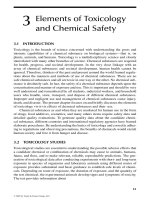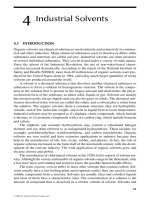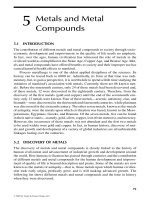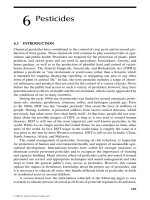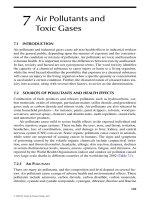Applications of Environmental Aquatic Chemistry: A Practical Guide - Chapter 1 docx
Bạn đang xem bản rút gọn của tài liệu. Xem và tải ngay bản đầy đủ của tài liệu tại đây (422.75 KB, 42 trang )
CRC Press is an imprint of the
Taylor & Francis Group, an informa business
Boca Raton London New York
Eugene R. Weiner
Second Edition
Applications of
Environmental
Aquatic
Chemistry
A Practical Guide
ß 2007 by Taylor & Francis Group, LLC.
CRC Press
Taylor & Francis Group
6000 Broken Sound Parkway NW, Suite 300
Boca Raton, FL 33487-2742
© 2008 by Taylor & Francis Group, LLC
CRC Press is an imprint of Taylor & Francis Group, an Informa business
No claim to original U.S. Government works
Printed in the United States of America on acid-free paper
10 9 8 7 6 5 4 3 2 1
International Standard Book Number-13: 978-0-8493-9066-1 (Hardcover)
This book contains information obtained from authentic and highly regarded sources Reason-
able efforts have been made to publish reliable data and information, but the author and publisher
cannot assume responsibility for the validity of all materials or the consequences of their use. The
Authors and Publishers have attempted to trace the copyright holders of all material reproduced
in this publication and apologize to copyright holders if permission to publish in this form has not
been obtained. If any copyright material has not been acknowledged please write and let us know so
we may rectify in any future reprint
Except as permitted under U.S. Copyright Law, no part of this book may be reprinted, reproduced,
transmitted, or utilized in any form by any electronic, mechanical, or other means, now known or
hereafter invented, including photocopying, microfilming, and recording, or in any information
storage or retrieval system, without written permission from the publishers.
For permission to photocopy or use material electronically from this work, please access www.
copyright.com ( or contact the Copyright Clearance Center, Inc. (CCC)
222 Rosewood Drive, Danvers, MA 01923, 978-750-8400. CCC is a not-for-profit organization that
provides licenses and registration for a variety of users. For organizations that have been granted a
photocopy license by the CCC, a separate system of payment has been arranged.
Trademark Notice: Product or corporate names may be trademarks or registered trademarks, and
are used only for identification and explanation without intent to infringe.
Library of Congress Cataloging-in-Publication Data
Weiner, Eugene R.
Applications of environmental aquatic chemistry : a practical guide / Eugene R.
Weiner. 2nd ed.
p. cm.
Rev. ed. of: Applications of environmental chemistry / Eugene R. Weiner. 2000.
Includes bibliographical references and index.
ISBN 978-0-8493-9066-1 (alk. paper)
1. Environmental chemistry. 2. Water quality. I. Weiner, Eugene R.
Applications of environmental chemistry. II. Title.
TD193.W45 2007
628.1’68 dc22 2007048068
Visit the Taylor & Francis Web site at
and the CRC Press Web site at
ß 2007 by Taylor & Francis Group, LLC.
Contents
Preface to the Second Edition
Preface to the First Edition
Author
Chapter 1
Water Quality
1.1 Defining Environmental Water Quality
1.1.1 Water-Use Classifications and Water Quality Standards
1.1.2 Water Quality Classifications and Standards
for Natural Waters
1.1.3 Setting Numerical Water Quality Standards
1.1.4 Typical Water-Use Classifications
1.1.4.1 Recreational
1.1.4.2 Aquatic Life
1.1.4.3 Agriculture
1.1.4.4 Domestic Water Supply
1.1.4.5 Wetlands
1.1.4.6 Groundwater
1.1.5 Staying Up-to-Date with Standards and Other Regulations
1.2 Sources of Water Impurities
1.2.1 Natural Sources
1.2.2 Human-Caused Sources
1.3 Measuring Impurities
1.3.1 What Impurities Are Present?
1.3.2 How Much of Each Impurity Is Present?
1.3.3 Working with Concentrations
1.3.4 Moles and Equivalents
1.3.4.1 Working with Equivalent Weights
1.3.5 Case History Example
1.3.6 How Do Impurities Influence Water Quality?
Exercises
Chapter 2
Contaminant Behavior in the Environment: Basic Principles
2.1 Behavior of Contaminants in Natural Waters
2.1.1 Important Properties of Pollutants
2.1.2 Important Properties of Water and Soil
2.2 What Are the Fates of Different Pollutants?
2.3 Processes That Remove Pollutants from Water
2.3.1 Natural Attenuation
ß 2007 by Taylor & Francis Group, LLC.
2.3.2 Transport Processes
2.3.3 Environmental Chemical Reactions
2.3.4 Biological Processes
2.4 Major Contaminant Groups and Natural Pathways for Their
Removal from Water
2.4.1 Metals
2.4.2 Chlorinated Pesticides
2.4.3 Halogenated Aliphatic Hydrocarbons
2.4.4 Fuel Hydrocarbons
2.4.5 Inorganic Nonmetal Species
2.5 Chemical and Physical Reactions in the Water Environment
2.6 Partitioning Behavior of Pollutants
2.6.1 Partitioning from a Diesel Oil Spill
2.7 Intermolecular Forces
2.7.1 Temperature Dependent Phase Changes
2.7.2 Volatility, Solubility, and Sorption
2.7.3 Predicting Relative Attractive Forces
2.8 Origins of Intermolecular Forces: Electronegativities,
Chemical Bonds, and Molecular Geometry
2.8.1 Chemical Bonds
2.8.2 Chemical Bond Dipole Moments
2.8.3 Molecular Geometry and Molecular Polarity
2.8.4 Examples of Nonpolar Molecules
2.8.5 Examples of Polar Molecules
2.8.6 The Nature of Intermolecular Attractions
2.8.7 Comparative Strengths of Intermolecular Attractions
2.9 Solubility and Intermolecular Attractions
Exercises
Chapter 3
Major Water Quality Parameters and Applications
3.1 Interactions among Water Quality Parameters
3.2 pH
3.2.1 Background
3.2.2 Defining pH
3.2.3 Acid-Base Reactions
3.2.4 Importance of pH
3.2.5 Measuring pH
3.2.6 Water Quality Criteria and Standards for pH
3.3 Oxidation–Reduction Potential
3.3.1 Background
3.4 Carbon Dioxide, Bicarbonate, and Carbonate
3.4.1 Background
3.4.2 Solubility of CO
2
in Water
3.4.3 Soil CO
2
ß 2007 by Taylor & Francis Group, LLC.
3.5 Acidit y and Alka linity
3.5.1 Background
3.5.2 Acidity
3.5.3 Alkalinity
3.5.4 Importance of Alkalinity
3.5.5 Water Quality Criteria and Standards for Alkalinity
3.5.6 Calculating Alkalinity
3.5.7 Calculating Changes in Alkalinity, Carbonate, and pH
3.6 Hardness
3.6.1 Background
3.6.2 Calculating Hardness
3.6.3 Importance of Hardness
3.7 Dissolved Oxygen
3.7.1 Background
3.8 Biological Oxygen Demand and Chemical
Oxygen Demand
3.8.1 Background
3.8.2 BOD
5
3.8.3 BOD Calculation
3.8.4 COD Calculation
3.9 Nitrogen: Ammonia, Nitrite, and Nitrate
3.9.1 Background
3.9.2 Nitrogen Cycle
3.9.3 Ammonia=Ammonium Ion
3.9.4 Water Quality Criteria and Standards for Ammonia
3.9.5 Nitrite and Nitrate
3.9.6 Water Quality Criteria and Standards for Nitrate
3.9.7 Methods for Removing Nitrogen from Wastewater
3.9.7.1 Air-Stripping Ammonia
3.9.7.2 Nitrification–Denitrification
3.9.7.3 Breakpoint Chlorination
3.9.7.4 Ammonium Ion Exchange
3.9.7.5 Biosynthesis
3.10 Sulfide and Hydrogen Sulfide
3.10.1 Background
3.10.1.1 Formation of H
2
S in Detention Ponds, Wetlands,
and Sewers
3.10.1.2 Typical Water Quality Criteria and Standards
for H
2
S
3.10.2 Case Study
3.10.2.1 Odors of Biological Origin in Water (Mostly
Hydrogen Sulfide and Ammonia)
3.10.2.2 Environmental Chemistry of Hydrogen Sulfide
3.10.2.3 Chemical Control of Odors
3.10.2.4 pH control
ß 2007 by Taylor & Francis Group, LLC.
3.10.2.5 Oxidation
3.10.2.6 Eliminate Reducing Conditions Caused
by Decomposing Organic Matter
3.10.2.7 Sorption to Activated Charcoal
3.11 Phosphorus
3.11.1 Background
3.11.2 Important Uses for Phosphorus
3.11.3 Phosphorous Cycle
3.11.4 Mobility in the Environment
3.11.5 Phosphorous Compounds
3.11.6 Removal of Dissolved Phosphate
3.12 Solids (Total, Suspended, and Dissolved)
3.12.1 Background
3.12.2 TDS and Salinity
3.12.3 Specific Conductivity and TDS
3.12.4 TDS Test for Analytical Reliability
3.13 Temperature
Exercises
Reference
Chapter 4
Behavior of Metal Species in the Natural Environment
4.1 Metals in Water
4.1.1 Background
4.1.2 Mobility of Metals in the Water Environment
4.1.3 General Behavior of Dissolved Metals in Water
4.1.3.1 Hydrolysis Reactions
4.1.3.2 Hydrated Metals as Acids
4.1.4 Influence of pH on the Solubility of Metals
4.1.5 Influence of Redox Potential on the Solubility of Metals
4.1.5.1 Redox-Sensitive Metals: Cr, Cu, Hg, Fe, Mn
4.1.5.2 Redox-Insensitive Metals: Al, Ba, Cd, Pb, Ni, Zn
4.1.5.3 Redox-Sensitive Metalloids: As, Se
4.2 Metal Water Quality Standards
4.3 Case Study 1
4.3.1 Treatment of Trace Metals in Urban Stormwater Runoff
4.3.2 Behavior of Common Stormwater Pollutants under Oxidizing
and Reducing Conditions
4.4 Case Study 2
4.4.1 Acid Rock Drainage
4.4.1.1 Summary of Acid Formation in Acid
Rock Drainage
4.4.1.2 Non-iron Metal Sulfides Do Not Generate Acidity
4.4.1.3 Acid-Base Potential of Soil
4.4.1.4 Determining the Acid-Base Potential
ß 2007 by Taylor & Francis Group, LLC.
4.5 Case Study 3
4.5.1 Identifying Metal Loss and Gain Mechanisms in a Stream
Exercises
References
Chapter 5
Soil, Groundwater, and Subsurface Contamination
5.1 Nature of Soils
5.1.1 Soil Formation
5.1.1.1 Physical Weathering
5.1.1.2 Chemical Weathering
5.1.1.3 Secondary Mineral Formation
5.1.1.4 Roles of Plants and Soil Organisms
5.2 Soil Profiles
5.2.1 Soil Horizons
5.2.2 Successive Steps in the Typical Development of a Soil
and Its Profile (Pedogenesis)
5.3 Organic Matter in Soil
5.3.1 Humic Substances
5.3.2 Some Properties of Humic Materials
5.3.2.1 Binding to Dissolved Species
5.3.2.2 Light Absorption
5.4 Soil Zones
5.4.1 Air in Soil
5.5 Contaminants Become Distributed in Water, Soil, and Air
5.5.1 Volatilization
5.5.2 Sorption
5.6 Partition Coefficients
5.6.1 Air–Water Partition Coefficient (Henry’s Law)
5.6.2 Soil–Water Partition Coefficient
5.6.3 Determining K
d
Experimentally
5.6.4 Role of Soil Organic Matter
5.6.5 Octanol–Water Partition Coefficient, K
ow
5.6.6 Estimating K
d
Using Measured Solubility or K
ow
5.7 Mobility of Contaminants in the Subsurface
5.7.1 Retardation Factor
5.7.2 Effect of Biodegradation on Effective Retardation Factor
5.7.3 A Model for Sorption and Retardation
5.7.4 Soil Properties
5.8 Particulate Transport in Groundwater: Colloids
5.8.1 Colloid Particle Size and Surface Area
5.8.2 Particle Transport Properties
5.8.3 Electrical Charges on Colloids and Soil Surfaces
5.8.3.1 Electrical Double Layer
5.8.3.2 Adsorption and Coagulation
ß 2007 by Taylor & Francis Group, LLC.
5.9 Case Study: Clearing Muddy Ponds
5.9.1 Pilot Jar Tests
5.9.1.1 Jar Test Procedure with Alum Coagulant
5.9.1.2 Jar Test Procedure with Gypsum Coagulant
Exercises
References
Chapter 6
General Properties of Nonaqueous Phase Liquids and the Behavior of Light
Nonaqueous Phase Liquids in the Subsurface
6.1 Types and Properties of Nonaqueous Phase Liquids
6.2 General Characteristics of Petroleum Liquids, the Most
Common LNAPL
6.2.1 Types of Petroleum Products
6.2.2 Gasoline
6.2.3 Middle Distillates
6.2.4 Heavier Fuel Oils and Lubricating Oils
6.3 Behavior of Petroleum Hydrocarbons in the Subsurface
6.3.1 Soil Zones and Pore Space
6.3.2 Partitioning of Light Nonaqueous Phase Liquids
in the Subsurface
6.3.3 Processes of Subsurface Migration
6.3.4 Petroleum Mobility Through Soils
6.3.5 Behavior of LNAPL in Soils and Groundwater
6.3.6 Summary: Behavior of Spilled LNAPL
6.3.7 Weathering of Subsurface Contaminants
6.3.8 Petroleum Mobility and Solubility
6.4 Formation of Petroleum Contamination Plumes
6.4.1 Dissolved Contaminant Plume
6.4.2 Vapor Contaminant Plume
6.5 Estimating the Amount of LNAPL Free Product in the Subsurface
6.5.1 How LNAPL Layer Thickness in the Subsurface Affects
LNAPL Layer Thickness in a Well
6.5.1.1 Effect of Soil Texture on LNAPL in the Subsurface
and in Wells
6.5.1.2 Effect of Water Table Fluctuations on LNAPL
in the Subsurface and in Wells
6.5.1.3 Effect of Water Table Fluctuations on LNAPL
Measurements in Wells
6.6 Estimating the Amount of Residual LNAPL Immobilized
in the Subsurface
6.6.1 Subsurface Partitioning Loci of LNAPL Fuels
6.7 Chemical Fingerprinting of LNAPLs
6.7.1 First Steps in Chemical Fingerprinting of Fuel Hydrocarbons
6.7.2 Identifying Fuel Types
ß 2007 by Taylor & Francis Group, LLC.
6.7.3 Age-Dating Fuel Spills
6.7.3.1 Gasoline
6.7.3.2 Changes in BTEX Ratios Measured in Groundwater
6.7.3.3 Diesel Fuel
6.8 Simulated Distillation Curves and Carbon Number Distribution
Curves
References
Chapter 7
Behavior of Dense Nonaqueous Phase Liquids in the Subsurface
7.1 DNAPL Properties
7.2 DNAPL Free Product Mobility
7.2.1 DNAPL in the Vadose Zone
7.2.2 DNAPL at the Water Table
7.2.3 DNAPL in the Saturated Zone
7.3 Testing for the Presence of DNAPL
7.3.1 Contaminant Concentrations in Groundwater and Soil
That Indicate the Proximity of DNAPL
7.3.2 Calculation Method for Assessing Residual DNAPL in Soil
7.4 Polychlorinated Biphenyls
7.4.1 Background
7.4.2 Environmental Behavior
7.4.3 Analysis of PCBs
7.4.4 Case Study: Mistaken Identification of PCB Compounds
References
Chapter 8
Biodegradation and Bioremediation of LNAPLs and DNAPLs
8.1 Biodegradation and Bioremediation
8.2 Basic Requirements for Biodegradation
8.3 Biodegradation Processes
8.3.1 Case Study
8.3.1.1 Passive (Intrinsic) Bioremediation of Fuel LNAPLs:
California Survey
8.4 Natural Aerobic Biodegradation of NAPL Hydrocarbons
8.5 Determining the Extent of Bioremediation of LNAPL
8.5.1 Using Chemical Indicators of the Rate of Intrinsic
Bioremediation
8.5.2 Hydrocarbon Contaminant Indicator
8.5.3 Electron Acceptor Indicators
8.5.4 Dissolved Oxygen Indicator
8.5.5 Nitrate Plus Nitrite Denitrification Indicator
8.5.6 Metal Reduction Indicators: Manganese (IV) to Manganese (II)
and Iron (III) to Iron (II)
8.5.7 Sulfate Reduction Indicator
8.5.8 Methanogenesis (Methane Formation) Indicator
ß 2007 by Taylor & Francis Group, LLC.
8.5.9 Redox Potential and Alkalinity as Biodegradation Indicators
8.5.9.1 Using Redox Potentials to Locate Anaerobic
Biodegradation within the Plume
8.5.9.2 Using Alkalinity to Locate Anaerobic Biodegradation
within the Plume
8.6 Bioremediation of Chlorinated DNAPLs
8.6.1 Reductive Dechlorination of Chlorinated Ethenes
8.6.2 Reductive Dechlorination of Chlorinated Ethanes
8.6.3 Case Study: Using Biodegradation Pathways
for Source Identification
References
Chapter 9
Behavior of Radionuclides in the Water and Soil Environment
9.1 Introduction
9.2 Radionuclides
9.2.1 A Few Basic Principles of Chemistry
9.2.1.1 Matter and Atoms
9.2.1.2 Elements
9.2.2 Properties of an Atomic Nucleus
9.2.2.1 Nuclear Notation
9.2.3 Isotopes
9.2.4 Nuclear Forces
9.2.5 Quarks, Leptons, and Gluons
9.2.6 Radioactivity
9.2.6.1 a Emission
9.2.6.2 b Emission
9.2.6.3 g Emission
9.2.7 Balancing Nuclear Equations
9.2.8 Rates of Radioactive Decay
9.2.8.1 Half-Life
9.2.9 Radioactive Decay Series
9.2.10 Naturally Occurring Radionuclides
9.3 Emissions and Their Properties
9.4 Units of Radioactivity and Absorbed Radiation
9.4.1 Activity
9.4.2 Absorbed Dose
9.4.3 Dose Equivalent
9.4.4 Unit Conversion Tables
9.4.4.1 Converting between Units of Dose Equivalent
and Units of Activity (Rems to Picocuries)
9.5 Naturally Occurring Radioisotopes in the Environment
9.5.1 Case Study: Radionuclides in Public Water Supplies
9.5.2 Uranium
9.5.2.1 Uranium Geology
9.5.2.2 Uranium in Water
ß 2007 by Taylor & Francis Group, LLC.
9.5.3 Radium
9.5.3.1 Radium in Soil
9.5.3.2 Radium in Water
9.5.4 Radon
9.5.4.1 Health Issues
Exercises
References
Chapter 10
Selected Topics in Environmental Chemistry
10.1 Agricultural Water Quality
10.2 Sodium Adsorption Ratio
10.2.1 What SAR Values Are Acceptable?
10.3 Deicing and Sanding of Roads: Controlling
Environmental Effects
10.3.1 Methods for Maintaining Winter Highway Safety
10.3.2 Antiskid Materials
10.3.2.1 Environmental Concerns of Antiskid Materials
10.3.3 Chemical Deicers
10.3.3.1 Chemical Principles of Deicing
10.3.3.2 Corrosivity
10.3.4 Environmental Concerns of Chemical Deicers
10.3.5 Deicer Components and Their Potential
Environmental Effects
10.3.5.1 Chloride Ion
10.3.5.2 Sodium Ion
10.3.5.3 Calcium, Magnesium, and Potassium Ions
10.3.5.4 Acetate
10.3.5.5 Impurities Present in Deicing Materials
10.4 Drinking Water Treatment
10.4.1 Water Sources
10.4.2 Water Treatment
10.4.3 Basic Drinking Water Treatment
10.4.3.1 Primary Settling
10.4.3.2 Aeration
10.4.3.3 Coagulation
10.4.3.4 Disinfection
10.4.3.5 Disinfection Procedures
10.4.4 Disinfection By-Products and Disinfection Residuals
10.4.5 Strategies for Controlling Disinfection By-Products
10.4.6 Chlorine Disinfection Treatment
10.4.6.1 Hypochlorite
10.4.6.2 Definitions
10.4.7 Drawbacks to Use of Chlorine: Disinfection
By-Products
ß 2007 by Taylor & Francis Group, LLC.
10.4.7.1 Trihalomethanes
10.4.7.2 Chlorinated Phenols
10.4.8 Chloramines
10.4.9 Chlorine Dioxide Disinfection Treatment
10.4.10 Ozone Disinfection Treatment
10.4.10.1 Ozone DBPs
10.4.11 Potassium Permanganate
10.4.11.1 Peroxone (Ozone Plus Hydrogen Peroxide)
10.4.11.2 Ultraviolet Disinfection Treatment
10.4.11.3 Membrane Filtration Water Treatment
10.5 Ion Exchange
10.5.1 Why Do Solids in Nature Carry a Surface Charge?
10.5.2 Cation- and Anion-Exchange Capacity (CEC)
10.5.3 Exchangeable Bases: Percent Base Saturation
10.5.4 CEC in Clays and Organic Matter
10.5.4.1 CEC in Clays
10.5.4.2 CEC in Organic Matter
10.5.5 Rates of Cation Exchange
10.6 Indicators of Fecal Contamination: Coliform
and Streptococci Bacteria
10.6.1 Background
10.6.2 Total Coliforms
10.6.3 Fecal Coliforms
10.6.4 Escherichia coli
10.6.5 Fecal Streptococci
10.6.6 Enterococci
10.7 Municipal Wastewater Reuse: The Movement and Fate
of Microbial Pathogens
10.7.1 Pathogens in Treated Wastewater
10.7.2 Transport and Inactivation of Viruses in Soils
and Groundwater
10.8 Oil and Grease
10.8.1 Oil and Grease Analysis
10.8.2 Silica Gel Treatment
10.9 Quality Assurance and Quality Control in Environmental Sampling
10.9.1 QA/QC Has Different Field and Laboratory Components
10.9.2 Essential Components of Field QA/QC
10.9.2.1 Sample Collection
10.9.3 Field Sample Set
10.9.3.1 Quality Control Samples
10.9.3.2 Blank Sample Requirements
10.9.3.3 Field Duplicates and Spikes
10.9.3.4 Understanding Laboratory Reported Results
10.10 Case Study: Water Quality Profile of Groundwater
in Coal-Bed Methane Formations
10.10.1 Geochemical Explanation for the Stiff Patterns
ß 2007 by Taylor & Francis Group, LLC.
10.10.1.1 Bicarbonate Anion Increase
10.10.1.2 Calcium and Magnesium Cation Decrease
10.10.1.3 Sodium Cation May Increase
10.10.1.4 Sulfate Anion Decrease
References
Appendix A
A Selective Dictionary of Water Quality Parameters and Pollutants
A.1 Introduction
A.1.1 Water Quality Inorganic Parameters: Classified by Abundance
A.2 Alphabetical Listing of Chemical and Physical Water Quality
Parameters and Pollutants
Answers to Selected Chapter Exercises
ß 2007 by Taylor & Francis Group, LLC.
ß 2007 by Taylor & Francis Group, LLC.
Preface to the Second Edition
Much new material has been added to this second edition. Besides a totally new
chapter on radionuclides, the text has been reorganized and updated with separate
chapters on metals, light nonaqueous phase liquids (LNAPLs), dense nonaqueous
phase liquids (DNAPLs), and biodegradation. Also, some end-of -chapter exercises
have been added. The dictionary of inorganic pollutants has been enlarged and
some important organic pollutants added. The former appendices listing drink ing
water standards, water quality criteria, and sample collecti on protocols have been
omitted because these data are continuall y changing and are readily available on the
Internet. However, the goals of the book remain the same—to help non-chemist
environmental professionals and students work with chemical information in their
work and studies.
ß 2007 by Taylor & Francis Group, LLC.
ß 2007 by Taylor & Francis Group, LLC.
Preface to the First Edition
By sensible definition, any by-product of a chemical operation for which there is no
profitable use is a waste. The most convenient, least expensive way of disposing of said
waste – up the chimney or down the river – is the best.
From American Chemical Industry – A History, by W. Haynes,
Van Nostrand Publishers, 1954
The quote above describes the usual approach to waste disposal as it was practiced in
the first half of the 1900’s. Current disposal and cleanup regulations are aimed at
correcting problems caused by such misguided advice and go further toward trying
to maintain a non-degrading environment. Regulations such as federal and state
Clean Water Acts have set in motion a great effort to identify the chemical com-
ponents and other characteristics which influence the quality of surface and ground-
waters and the soils through which they flow. The number of drinking water
contaminants regulated by the United States Government has increased from about
five in 1940 to over 150 in 1999.
There are two distinct spheres of interest for an environmental professional,
the ever-changing, constructed sphere of regulations and the comparatively
stable sphere of the natural environment. Much of the regulatory sphere is bounded
by classifications and numerical standards for waters, soils, and wastes. The envir-
onmental sphere is bounded by the innate behavior of chemicals of concern.
While this book focuses on the environmental sphere, it makes an excursion into a
small part of the regulatory sphere in Chapter 1, where the rationale for stream
classifications and standards and the regul atory definition of water quality are
discussed.
This book is intended to be a guide and reference for professionals and students.
It is structured to be especially useful for those who must use the concepts of
environmental chemistry but are not chemists and do not have the time and=or
inclination to learn all the relevant background material. Chemistry topics that are
most important in environmental applications are succinctly summarized, with a
genuine effort to walk the middle ground between too much and too little informa-
tion. Frequent ly used reference materials are also included, such as water solubilities,
partition coefficients, natural abundance of trace metals in soil, and federal drinking
water standards. Particularly useful are the frequent ‘‘rules-of-thumb’’ lists, which
conveniently offer ways to quickly estimate important aspects of the topic being
discussed.
Although it is often true that ‘‘a little knowledge can be dangerous’’, it is also
true that a little chemical knowledge of the ‘‘right sort’’ can be a great help to the
busy non-chemist. Although no ‘‘practical guide’’ will please everyone with its
choice of inclusions and omissions, I have based my choices on the most frequently
ß 2007 by Taylor & Francis Group, LLC.
asked questions from my colleagues and the material I find myself looking-up over
and over again. The main goal of this book is to offer non-chemist readers enough
chemical insight to help them contend with those environmental chemistry problems
that seem to arise most frequently in the work of an environmental professional.
Environmental chemists and students of environmental chemistry should also find
the book valuable as a general-purpose reference.
ß 2007 by Taylor & Francis Group, LLC.
Author
Eugene R. Weiner, PhD is professor emeritus of chemistry at the University of
Denver, Colorado. In 1965 he joined the University of Denver’s faculty. From 1967
to 1992, he was a consultant with the U.S. Geological Survey, Water Resources
Division in Denver, and has consulted on environmental issues for many other
private, state, and federal entities. After 27 years of research and teaching environ-
mental and physical chemistry, he joined Wright Water Engineers Inc., an environ-
mental and water resources engineering firm in Denver, as a senior scientist.
He received a BS in mathematics from Ohio University, an MS in physics from
the University of Illinois, and a PhD in chemistry from Johns Hopkins University.
He has authored and coauthored more than 400 research articles, books, and tech-
nical reports. In recent years, he has conducted 16 short courses, dealing with the
movement and fate of contaminants in the environment, in major cities around the
United States for the continuing education program of the American Society of Civil
Engineers.
ß 2007 by Taylor & Francis Group, LLC.
ß 2007 by Taylor & Francis Group, LLC.
1
Water Quality
1.1 DEFINING ENVIRONMENTAL WATER QUALITY
Water quality means different things to different people, depending on their goals for
the water. A chemist in the laboratory will regard high-quality laboratory water as
water free from chemical impurities or suspended solids. High-quality environmental
water has different criteria. The same chemist on a wilderness backpack trip might
identify high-quality water as water in a pristine environment unaltered by human
activity. If the chemist is also a fisherman, she or he might regard high-quality water
as a good habitat for fish and other aquatic organisms. A drinking water treatment
plant manager will define high-quality water as water with a minimum amount of
substances that have to be removed or treated to produce safe and palatable drinking
water. A broad view of high-quality water will take into consideration its suitability
for particular uses.
The U.S. Congress recognized this when they enacted the Federal Water Pollu-
tion Control Act Amendments of 1972 (Public Law 92500, also known as the Clean
Water Act) where it is stated, ‘‘The objective of this act is to restore and maintain the
chemical, physical, and biological integrity of the Nation’s waters.’’ In the law, water
quality is a measure of its suitability for particular designated uses. Implementing the
law entails identifying these uses, setting standards that are protective of the desig-
nated uses, and providing enforcement procedures that require compliance with the
standards.
1.1.1 WATER-USE CLASSIFICATIONS AND WATER QUALITY STANDARDS
In most parts of the world, the days are long gone when rivers, lakes, springs, and
wells from which one can directly drink could readily meet almost all needs for high-
quality water. Where such water remains, mostly in high mountain regions
untouched by mining, grazing, or industrial fallout, it must be protected by strict
regulations. In the United States, many states seek to preserve high-quality waters
with antidegradation policies. But most of the water that is used for drinking water
supplies, irrigation, and industry, not to mention supplying a supporting habitat for
natural flora and fauna, is much-reused water that often needs treatment to become
acceptable.
Whenever it is recognized that water treatment is required, new issues arise
concerning the degree of water quality sought, the costs involved, and, perhaps,
restrictions imposed on the uses of the water. Since it is economically impossible to
make all waters suitable for all purposes, it becomes necessary to designate for which
uses various waters are suitable.
ß 2007 by Taylor & Francis Group, LLC.
In this context, a practical evaluation of water quality depends on how the water
is used, as well as its chemical makeup. The quality of water in a stream might be
considered good if the water is used for irrigation but poor if it is used as a drinking
water supply. To determine water quality, one must first identify the ways in which
the water will be used and only then determine appropriate numerical standards
for important water quality parameters that will support and protect the designated
water uses.
Strictly speaking, a water impurity is any substance in the water that is not a part
of a water molecule, and absolutely pure water is unattainable in any realistic water
sample. High-quality water is not pure; it just contains amounts of impurities too
small to be harmful to its intended uses. Many impurities in water are beneficial. For
example, carbonate (CO
2À
3
) and bicarbonate (HCO
2À
3
) make water less sensitive to
acid rain and acid mine drainage; hardness and alkalinity decrease the solubility and
toxicity of metals; nutrients, dissolved carbon dioxide (CO
2
), and dissolved oxygen
(O
2
) are essential for aquatic life. Outside a chemical labor atory, extremely pure
water generally is not desirable. Water with very low concentrations of dissolved
impurities is more corrosive (aggressive) to metal pipes than water containing a
measure of hardness, it cannot sustain aquatic life, and it certainly does not taste as
good as natural water saturated with dissolved oxygen and containing a healthy mix
of minerals.
In this book, the following definitions are used:
.
A water impurity is any substance in water that is not derived from a water
molecule only,* regardless of whether it is considered harmful, beneficial,
or neutral to the intended uses of the water.
.
A water pollutant or contaminant is any substance in water that is not
derived from a water molecule only, and is considered, when present in
sufficient concentration, to be harmful to the water’s intended uses.
For most purposes, the quality of water is not judged by its purity but rather by its
suitability for the different uses intended for it. The water contaminant nitrate (NO
À
3
)
illustrates this point. In drinking water supplies, nitrate concentrations greater than
10 mg=L are considered a potential health hazard, particularly to young children. On
the other hand, nitrate is a beneficial plant nutrient in agricultural water and is added
as a fertilizer. Water containing more than 10 mg=L of nitrate is of poor quality if it is
used for potable water but may be of good quality for agricultural use.
Thus, water uses must be identified before water quality can be judged. Once the
water uses are defined, numerical water quality standards for harmful impurities can
be established to protect each use.
There are three different types of water quality standards set by state and federal
regulations:
* The species H
þ
,OH
À
,H
3
O
þ
, H
5
O
þ
2
can all be derived from water molecules only. Species such as Cl
À
,
Na
þ
, MnO
À
4
, Ca(OH)
2
, etc., clearly cannot.
ß 2007 by Taylor & Francis Group, LLC.
1. Surface and groundwater standards, for the ambient quality of natural
waters (rivers, lakes, reservoirs, wetlands, and groundwater). These stand-
ards are chosen to protect the current and intended uses of natural waters, as
discussed later.
2. Effluent standards, controlled by discharge permits under the National
Pollutant Discharge Elimination System (NPDES). Effluent standards are
chosen so that wastewaters discharging into natural waters do not cause the
receiving waters to exceed their surface and groundwater standards. Efflu-
ent standards are affected by the ambient standards for the receiving water,
the assimilation capacity of the receiving water, the total pollutant load
contributed by all dischargers into that water, etc.
3. Drinking water standards, which apply both to groundwater used as a public
water supply and to water delivered to the public from drinking water
treatment plants. Drinking water standards are chosen to protect the public
health.
1.1.2 WATER QUALITY CLASSIFICATIONS AND STANDARDS
FOR
NATURAL WATERS
The following preliminary steps, taken by a state or federal agency, are a common
approach to evaluating water quality in natural waters:
1. Define in general the basic purposes for which natural waters will poten-
tially be used (water supply, aquatic life, recreation, agriculture, etc.). These
will be the categories used for classifying uses for existing bodies of water.
2. Set numerical water quality standards for physical and chemical character-
istics that will support and protect the different water-use categories.
3. Compare the water quality standards with field measurements of existing
bodies of water, and then assign appropriate use classifications to the water
bodies according to whether their present or potential quality is suitable for
the assigned water uses.
After a natural body of water is classified for one or more uses, compile an
appropriate set of numerical standards to protect its assigned use classifications.
Where different assigned classifications have different standards for the same para-
meter, the more stringent standard will apply.
It is clear that measuring the chemical composition of a water sample collected in
the field is just one step in determining water quality. The sample data must then be
compared with the standards assigned to that water body. If no standards are
exceeded, the water quality is defined as good within its classified uses. As new
information is collected about environmental and health effects of individual water
constituents, it may be necessary to revise the standards for different water uses.
Federal and state regulations require that water quality standards be reviewed
periodically and modified when appropriate.
In addition to the review process for existing standards, the Safe Drinking Water
Act requires the Environmental Protection Agency (EPA) to periodically publish a
ß 2007 by Taylor & Francis Group, LLC.
Dri nking Wa ter Con taminant Candidat e List (C CL), a lis t of contam inants that , ‘‘at
the time of publicati on, are not subje ct to any propos ed or promulgat ed national
prim ary drinking wat er regulatio ns, are known or anti cipated to occur in publi c water
syst ems, and may require regul ations. ’’* Con taminants on the lis t are studied until
EPA conclu des that there are suf ficient data and infor mation to eith er propos e
app ropriate regul atio ns or conclu de that no acti on is curren tly necess ary.
1.1.3 S ETTING NUMERICAL WATER QUALITY S TANDARDS
Num erical water quali ty stand ards are chosen to protect the curren t an d intended uses
(clas sifi cations) for en vironment al waters. The water quality stand ards for each water
bo dy are based on all the uses for which it is classi fied. In addit ion, site-spec i fic
stand ards may b e estab lished wher e special condit ions exist, such as where aqua tic
lif e has becom e acclimat ed to high levels of dissolved metals. Each state has tables of
wat er quali ty standards for each classi fied water body. In addit ion to stand ards for
env ironment al wat ers, there are separate human health-bas ed stand ards for ground-
wat er used for public drinking water suppl ies, and for treated drinking wat er as
deli vered from a water treatmen t plant or, for some param eters such as lead and
cop per, as delivered at the tap.
The states, not the U.S. EPA, have the primary respon sibility for setting water
qu ality standards. However , EPA sets basel ine stand ards for different use classi fica-
tion s that serve as minim um requi reme nts for the state stand ards. In addition, EPA
issu es guidan ce and model regul ations regard ing stand ards, and EPA approva l is
requi red before stand ards can be adopte d or changed by states.
Water quality stand ards are de fined in terms of
.
Che mical co mposition: Con centratio ns of met als, organi c compo unds,
ch lorine, nitrates, amm onia, phospho rus, sulfate, etc.
.
Gene ral physi cal and chemi cal proper ties: Tempera ture, alkal inity,
co nductivity, p H, diss olved oxygen , hardness, tota l diss olved solids
(T DS), chemi cal oxygen deman d, etc.
.
Bi ological charact eristics : Biological oxygen deman d, Esc herichia coli ,
fecal coliform s, whol e ef flue nt toxicit y (WET), etc.
.
Rad ionuclides : Rad ium-226, radiu m-228, urani um, radon, gross alpha and
gross beta emissions, etc.
1.1.4 TYPICAL WATER-USE CLASSIFICATIONS
All stat es classify surface waters and groundwater according to their current and
intended uses. Typical classifications are described in the following sections.
1.1.4.1 Recreational
Class 1—Primary contact: These surface waters are suitable or intended to become
suitable for recreational activities in or on the water when the ingestion of small
* More information may be found at: www.epa.gov=safewater=ccl=index.html.
ß 2007 by Taylor & Francis Group, LLC.
quantities of water is likely to occur and prolonged and intimate contact with the
body is expected, e.g., swimming, rafting, kayaking, tubing, windsurfing, water-
skiing, etc. The Clean Water Act requires that waters shall be presumed, by default,
to be suitable or potentially suitable for class 1 uses, unless a use attainability
analysis demonstrates that there is not a reasonable potential for primary contact
uses to occur in the water segments in question within the next 20 year period. For
waters that are not currently suitable for class 1 status but could be restored within 20
years, states may subdivide the primary contact recreation classification into class 1a
and class 1b:
Class 1a—Existing primary contact : Class 1a waters are those in which
primary contact uses have been documented or are presumed to be present.
Waters for which no use attainability analysis has been performed demon-
strating that a recreation class 2 classification is appropriate shall be
assigned a class 1a classification, unless a reasonable level of inquiry has
failed to identify any existing class 1 uses of the water segment.
Class 1b—Potential primary contact: This classification shall be assigned to
water segments for which no use attainability analysis has been performed
demonstrating that a recreation class 2 classification is appropriate, and a
reasonable level of inquiry has failed to identify any existing class 1 uses of
the water segment.
Class 2—Secondary contact: Surface waters not suitable for a primary contact
classification but are suitable or intended to become suitable for recreational uses
in or around the water, which are not included in the primary contact categories,
e.g., wading, fishing, motor yachting, and other streamside or lakeside recreation
activities.
1.1.4.2 Aquatic Life
Surface waters that presently support aquatic life uses as described below, or may
reasonably be expected to do so in the future due to the suitability of present
conditions. Aquatic life classifications also apply to waters that are intended to
become suitable for such uses as a goal. Separate standards should be applied to
protect:
Class 1—Cold water aquatic life: These are waters that (1) are currently capable of
sustaining a wide variety of cold water biota (considered to be the inhabitants of
water in which temperatures normally do not exceed 208C), including sensitive
species or (2) could sustain such biota but for correctable water quality conditions.
Waters shall be considered capable of sustaining such biota where physical habitat,
water flows or levels, and water quality conditions result in no substantial impair-
ment of the abundance and diversity of species.
Class 1—Warm water aquatic life: The se are waters that (1) are currently capable
of sustaining a wide variety of warm water biota (considered to be the inhabitants
of water in which temperatures normally exceed 208C), including sensitive species
ß 2007 by Taylor & Francis Group, LLC.




